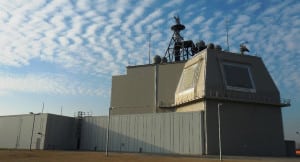The Defense Department is working with the government of Japan to address its concerns after it suspended the planned two Aegis Ashore system deployments due to technical and cost issues.
“We’re working very closely with them to resolve concerns and issues,” Missile Defense Agency director Vice Adm. Jon Hill said on Thursday during the online Defense One Tech Summit event.

Hill added that “we just have some work we have to do with Japan to lift the suspension so to speak. But I would defer most questions to the government of Japan because that is a very recent decision.”
Earlier this week, Japan decided to suspend deployment of the two Aegis Ashore sites because it has proven difficult to ensure the Standard Missile (SM-3) Block IIA interceptor rocket booster would land in a Japan Self-Defense Forces training area or the sea as promised without hardware modifications (Defense Daily, June 15).
Defense Minister Taro Kono said talks with the U.S. led the Japanese government to conclude they could not guarantee the safety of the population around the two chosen missile defense sites with software modifications alone.
Japan’s government has also faced consistent opposition from local politicians and citizens from the proposed bases in the northern prefecture of Akita and the southern prefecture of Yamaguchi.
When asked how worried he was by this development, Hill said, “I think that there are other options in the near term for the government of Japan for national missile defense. And again it’s a suspension, so obviously some concerns and some work that we’ll do with Japan.”
Japan first announced its plans to expand missile defense systems, include Aegis Ashore, in 2017 (Defense Daily, Aug. 18, 2017).
Then, last year, the State Department approved a possible $2.15 billion Foreign Military Sale to Japan to buy two Aegis Weapon Systems for the Aegis Ashore plans (Defense Daily, Jan. 29, 2019).
He added that from a U.S. missile defense perspective the Defense Department will leverage every sensor and weapon out there if needed.
So whether they build those or not–if they’re there–we’ll use them. If not, we have other options.”
Hill also confirmed he sees no implications for the SM-3 IIA cooperative development project between the U.S. and Japan.
“It’s really separate and distinct from the SM-3 cooperative development. That’s a separate Foreign Military Sales case. That development is complete. We’re going to production with the SM-3 Block IA, separate and distinct. It would be leveraged by Aegis Ashore.”
The SM-3 is designed to defend against medium-range ballistic missiles in the midcourse phase of flight. The Block IIA version is a cooperative program between the U.S. and Japan to increase the interceptor’s speed and range to defend against short, medium, and intermediate-range ballistic missiles.